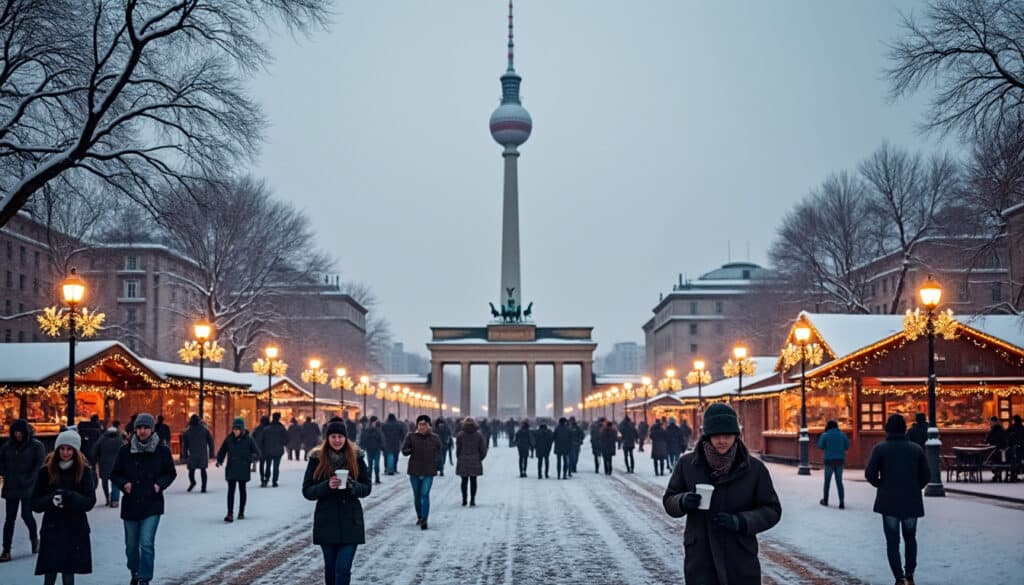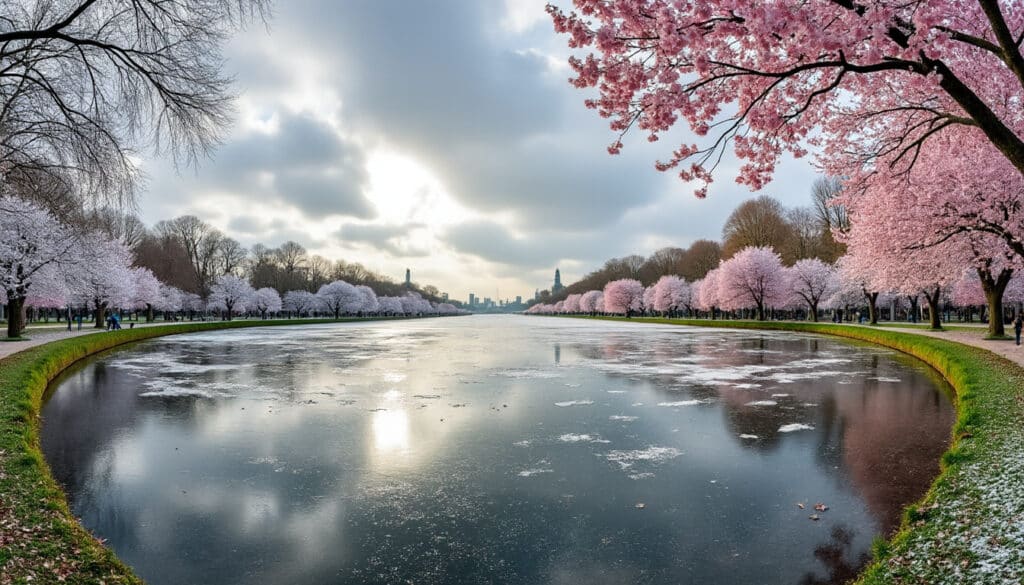Berlin, the vibrant cultural hub of Germany, transforms into a serene winter wonderland during the colder months. While this city is often celebrated for its dynamic nightlife and rich history, its winter season draws attention for a different reason: snowfall. ❄️ As temperatures drop and snowflakes begin to fall, Berlin becomes a picturesque setting reminiscent of a storybook landscape. From snow-laden trees in the parks to bustling streets dusted in white, Berlin under snow is a sight to behold. For those intending to visit or reside in Berlin, understanding the aspects of its snowy winters is essential to fully embrace the city’s charm.
Why Does It Snow in Berlin? – The Science Behind Berlin’s Snowy Winters
Berlin’s snowfall is predominantly influenced by its continental climate. Located far from large bodies of water, Berlin experiences cold air masses from Eastern Europe that play a key role in shaping its winter climate. This positioning causes Berlin to be colder during winter months, fostering conditions conducive to snowfall. The months from December to February typically witness the coldest temperatures, often dropping below freezing. The lower temperatures coincide with the influx of snowy weather, as moisture-laden air clashes with these cold fronts.
Furthermore, meteorological phenomena such as the “Siberian High” can bring cold northeasterly winds from Siberia to northern Europe, including Berlin. This phenomenon can significantly enhance snow occurrences in the city. Another contributing factor is the city’s altitude. Berlin, though not high-altitude in comparison to mountainous regions, has enough elevation that facilitates snowfall under right conditions.
Here’s an overview of the typical temperature range in Berlin during winter months, showcasing the kind of climate that can lead to snowfall:
| Month | Average Temperature (°C) | Snowfall (cm) | Days of Snowfall |
|---|---|---|---|
| December | 0 to 4 | 8 | 7 |
| January | -1 to 3 | 13 | 12 |
| February | 0 to 5 | 10 | 9 |
| March | 1 to 8 | 6 | 1 |

As these figures demonstrate, the average temperature in winter months is often conducive to snowfall, particularly in January, the coldest and snowiest month. For outdoor lovers, brands like The North Face, Patagonia, and Columbia prove invaluable in providing the necessary gear to comfortably experience Berlin’s winter magic.
The Role of Air Masses and Geographical Location
Berlin’s geographical location further contributes to its winter weather dynamics. The meeting points of different air masses can frequently occur over the region, where warm maritime air clashes with cold continental air. This interaction leads to the atmospheric instability necessary for snowfall. Additionally, Berlin, being set inland, lacks the moderating influence of oceans, resulting in more pronounced temperature dips in winter.
Frequency and Duration of Snow in Berlin – More than Just a Dusting
On average, Berlin receives snowfall on approximately 28 days during the winter season. However, it’s important to note that these events aren’t continuous; snow may fall for just a few hours or persist across several days. 🗓️ This variation lends an unpredictable yet exciting nature to Berlin’s winters where periods of snow can suddenly blanket the city in white.
Here is an overview of the frequency and longest durations of snow events in Berlin:
| Month | Average Snow Days | Longest Snowfall Event |
|---|---|---|
| December | 7 | 3 days |
| January | 12 | 5 days |
| February | 9 | 4 days |
| March | 1 | 2 days |
These figures emphasize January as the peak month for snowfall—not just in quantity but also in the continuity of snowy weather. Many Berlin residents and visitors see this as an opportunity to engage in winter activities. Skiing in nearby locations and ice skating are popular during this time, with gear from Marmot, Salomon, and REI proving to be excellent options for keeping warm and active.
Noteworthy Snow Events in Berlin
Berlin has seen some unforgettable snow events over the years. The notorious “Snowmageddon” in December 2010 stands out, turning the city into a winter spectacle and posing challenges for transport and services. ❄️ Such events, despite their disruptive potential, are a testament to the city’s resilience and charm during harsh winter conditions.
Seasonal Snowfall Patterns in Berlin – How the Year Unfolds
During winter, Berlin showcases the quintessential seasonal changes with transitions that are both scenic and atmospheric. Winter months transform the city with its layers of snow creating a wonderland, juxtaposed against the city’s modern and historic architecture.
Here’s a breakdown of how snow in Berlin evolves across the seasons:
| Season | Climate Characteristics | Snowfall Activity |
|---|---|---|
| Winter (Dec-Feb) | Cold, snowy | Frequent snow days, moderate accumulation |
| Spring (Mar-May) | Transition, warming | Decreasing snow, melting |
| Summer (Jun-Aug) | Warm, sunny | No snow |
| Fall (Sep-Nov) | Cool, crisp | Occasional early snow |
The winter season in particular offers a unique side of Berlin, where tromping around in gear from Mountain Hardwear, Burton, and Spyder becomes part of the Berlin lifestyle. When snow hits early in the fall or lingers in early spring, it creates enchanting mixes of blooming flowers and snowy grounds—an ironic and beautiful spectacle.
The Impact of Winter Infrastructure and Culture
Berlin’s infrastructure is well-equipped to handle its winter weather. Snowplows and gritting of roads are common sights, ensuring that life continues with minimal disruption. Additionally, the city embraces this season culturally with events and activities tailored for the colder months, including popular Christmas markets which attract both locals and tourists. It’s also a time where any giant in winter wear, like Canada Goose, seamlessly becomes part of daily attire.
FAQs About Snow in Berlin
- ❓ When does it start snowing in Berlin? Generally, snow starts falling in late November, but the most snowfall is seen in December through February.
- ❓ How do locals prepare for snowfall? Winter clothing from reputable brands is common. Berlin’s infrastructure ensures that public transportation and roadways are cleared for consistent movement.
- ❓ Is Berlin equipped for snow events? Yes, Berlin has robust snow management practices including regular road maintenance, ensuring limited disruptions.
- ❓ Can tourists enjoy snow activities in Berlin? Absolutely! Visitors can enjoy activities such as ice skating and sledding in various parks around the city.
- ❓ What is snowfall’s impact on daily life? Snow can cause minor delays but culturally brings together communities through winter festivities and vibrant outdoor activities.
For more detailed climate information, here’s an informative link: Berlin Climate Weather. And for those curious about dressing smart for Berlin’s chilly embrace, here’s another: Cold Weather Tips in Berlin.

Navigating the climate in Berlin involves understanding its unique variations across the seasons. The city, known for its cultural vibrancy and historical significance, experiences a maritime temperate climate that influences both residents and tourists. Whether you’re strolling the streets of…

As winter descends upon Berlin, the city’s vibrant streets transform into a mystical canvas painted with frosty hues. Locals and visitors alike brace for the biting chill, exploring unique ways to embrace the city’s cold climate. From cozy cafés to…

Flooding and natural risks in Berlin
The vibrant city of Berlin, known for its rich history and dynamic urban culture, faces its share of natural challenges, particularly flooding. With its intricate network of rivers and canals, Berlin’s flood risks have increasingly become a focal point for…

Berlin, the vibrant capital of Germany, is no stranger to fluctuating weather patterns. As summer approaches, it transforms into a bustling hub where residents and tourists alike bask in the warmth of the season. With its distinct urban culture and…

Berlin, a vibrant city teeming with history, culture, and a unique urban lifestyle, also presents a unique climate dynamic characterized by varying humidity levels throughout the year. For anyone interested in exploring the German capital, understanding the city’s atmospheric nuances…

Is Berlin warm throughout the year?
Berlin, the bustling capital of Germany, is a city rich in history, culture, and diverse climate patterns. As a key player in the cultural and political landscape of Europe, understanding Berlin’s weather throughout the year is crucial for both residents…

Rain and precipitation in Berlin
Berlin, well-known for its rich historical and cultural heritage, is also characterized by its distinct climate patterns. The city receives an average of 591 mm of rainfall annually, making rain and precipitation a significant aspect of life here. This article…

Berlin, Germany’s vibrant capital, experiences a fascinating array of seasonal changes throughout the year. Each season brings its unique charm to this bustling metropolis, making Berlin a captivating destination no matter the time of year. From the Winter Wonderland of…

The city of Berlin, capital of Germany, boasts a rich tapestry of culture and history, but many might not realize the weather here is just as compelling. Situated at a latitude of approximately 52 degrees north, Berlin experiences a moderately…

Berlin, with its vibrant culture and rich history, attracts millions of tourists each year. A key factor to consider when planning your visit is the weather, which shifts dramatically from month to month. This article provides an in-depth look at…

What is the weather like in Berlin?
Berlin, the vibrant capital of Germany, is known not only for its rich history and dynamic cultural scene but also for its unique weather patterns that can vastly vary throughout the year. Whether you’re a resident soaking in the Berlin…


